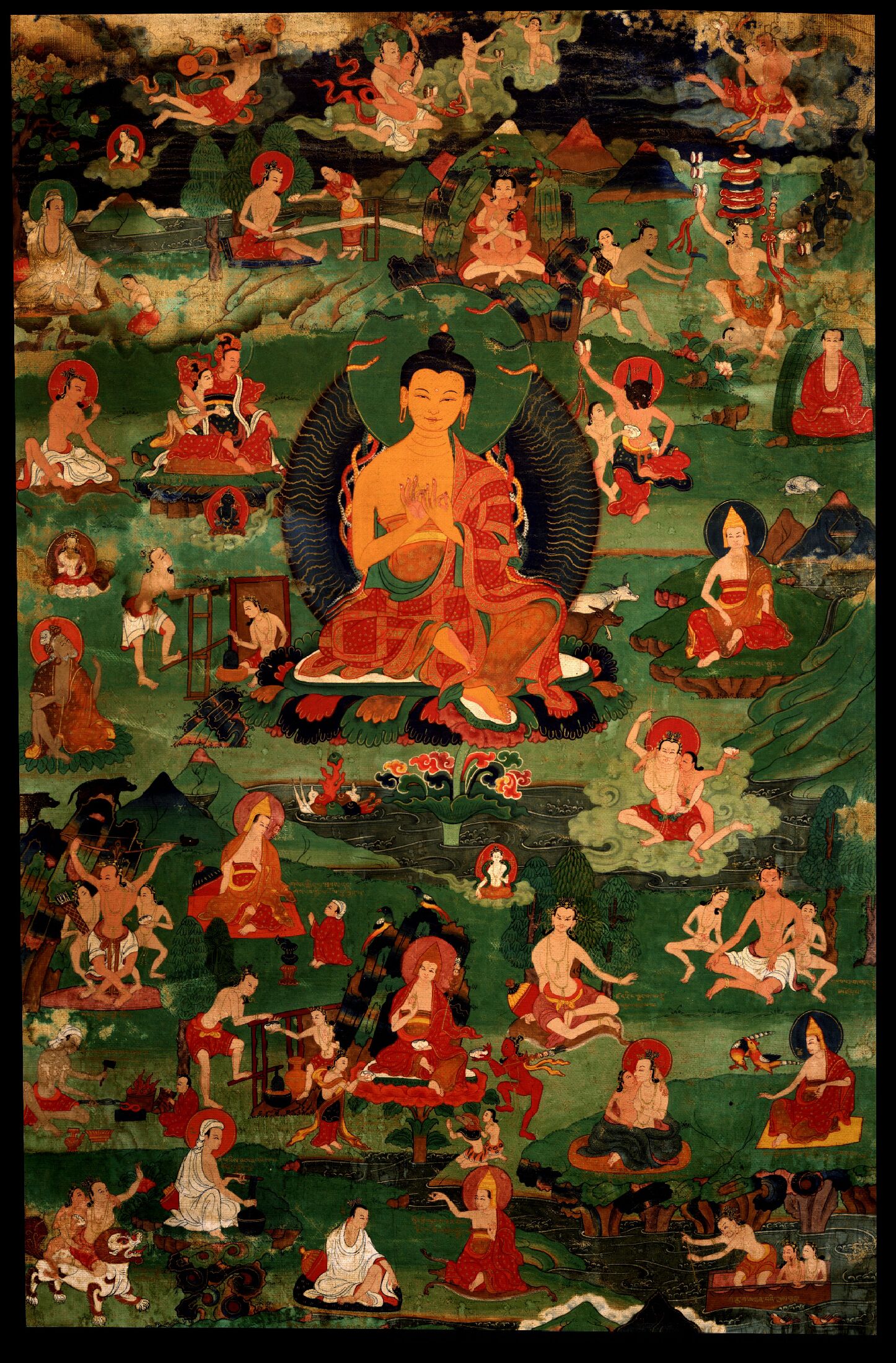|
Two Truths Doctrine
The Buddhism, Buddhist doctrine of the two truths (Sanskrit: '','' ) differentiates between two levels of ''satya'' (Sanskrit; Pāli: ''sacca''; meaning "truth" or "reality") in the teaching of Gautama Buddha, Śākyamuni Buddha: the "conventional" or "provisional" (''saṁvṛti'') truth, and the "absolute" or "ultimate" (''paramārtha'') truth. The exact meaning varies between the various Schools of Buddhism, Buddhist schools and Southern, Eastern and Northern Buddhism, traditions. The best known interpretation is from the Madhyamaka, Mādhyamaka school of Mahayana, Mahāyāna Buddhism, whose founder was the 3rd-century History of Buddhism in India, Indian Buddhist monk and philosopher Nagarjuna, Nāgārjuna. For Nāgārjuna, the two truths are ''epistemological truths''. The phenomenal world is accorded a provisional existence. The character of the phenomenal world is declared to be neither real nor unreal, but logically indeterminable. Ultimately, Śūnyatā, all phenomena are ... [...More Info...] [...Related Items...] OR: [Wikipedia] [Google] [Baidu] |
Buddhism
Buddhism, also known as Buddhadharma and Dharmavinaya, is an Indian religion and List of philosophies, philosophical tradition based on Pre-sectarian Buddhism, teachings attributed to the Buddha, a wandering teacher who lived in the 6th or 5th century Before the Common Era, BCE. It is the Major religious groups, world's fourth-largest religion, with about 500 million followers, known as Buddhists, who comprise four percent of the global population. It arose in the eastern Gangetic plain as a movement in the 5th century BCE, and gradually spread throughout much of Asia. Buddhism has subsequently played a major role in Asian culture and spirituality, eventually spreading to Western world, the West in the 20th century. According to tradition, the Buddha instructed his followers in a path of bhavana, development which leads to Enlightenment in Buddhism, awakening and moksha, full liberation from ''Duḥkha, dukkha'' (). He regarded this path as a Middle Way between extremes su ... [...More Info...] [...Related Items...] OR: [Wikipedia] [Google] [Baidu] |
Anattā
In Buddhism, the term ''anattā'' () or ''anātman'' () is the doctrine of "no-self" – that no unchanging, permanent self or essence can be found in any phenomenon. While often interpreted as a doctrine denying the existence of a self, ''anatman'' is more accurately described as a strategy to attain non-attachment by recognizing everything as impermanent, while staying silent on the ultimate existence of an unchanging essence. In contrast, dominant schools of Hinduism assert the existence of Ātman as pure awareness or witness-consciousness, "reify ngconsciousness as an eternal self". Etymology and nomenclature ''Anattā'' is a composite Pali word consisting of ''an'' (not) and ''attā'' (self-existent essence). The term refers to the central Buddhist concept that there is no phenomenon that has a permanent, unchanging "self" or essence. It is one of the three characteristics of all existence, together with '' dukkha'' (suffering, dissatisfaction) and '' anicca'' (imperm ... [...More Info...] [...Related Items...] OR: [Wikipedia] [Google] [Baidu] |
Sassatavada
Sassatavada (Pali), also śāśvata-dṛṣṭi (Sanskrit), usually translated "eternalism", is a kind of thinking rejected by the Buddha in the nikayas (and agamas). One example of it is the belief that the individual has an unchanging self. Views of this kind were held at the Buddha's time by a variety of groups. The Buddha rejected this and the opposite concept of ''ucchedavada'' ( annihilationism) on both logical and epistemic grounds. He proposed a Middle Way between these extremes, relying not on ontology Ontology is the philosophical study of existence, being. It is traditionally understood as the subdiscipline of metaphysics focused on the most general features of reality. As one of the most fundamental concepts, being encompasses all of realit ... but on causality. Eternalism included the belief that the extinction of things means their latency and the production of things means their manifestation — this violates the Buddha's principle of the middle way.K. Venkat ... [...More Info...] [...Related Items...] OR: [Wikipedia] [Google] [Baidu] |
Metaphysics
Metaphysics is the branch of philosophy that examines the basic structure of reality. It is traditionally seen as the study of mind-independent features of the world, but some theorists view it as an inquiry into the conceptual framework of human understanding. Some philosophers, including Aristotle, designate metaphysics as first philosophy to suggest that it is more fundamental than other forms of philosophical inquiry. Metaphysics encompasses a wide range of general and abstract topics. It investigates the nature of existence, the features all entities have in common, and their division into categories of being. An influential division is between particulars and universals. Particulars are individual unique entities, like a specific apple. Universals are general features that different particulars have in common, like the color . Modal metaphysics examines what it means for something to be possible or necessary. Metaphysicians also explore the concepts of space, time, ... [...More Info...] [...Related Items...] OR: [Wikipedia] [Google] [Baidu] |
Buddha-nature
In Buddhist philosophy and soteriology, Buddha-nature ( Chinese: , Japanese: , , Sanskrit: ) is the innate potential for all sentient beings to become a Buddha or the fact that all sentient beings already have a pure Buddha-essence within themselves.Heng-Ching ShihThe Significance Of 'Tathagatagarbha' – A Positive Expression Of 'Sunyata'/ref> "Buddha-nature" is the common English translation for several related Mahāyāna Buddhism, Buddhist terms, most notably ''tathāgatagarbha'' and ''buddhadhātu'', but also ''sugatagarbha,'' and ''buddhagarbha''. ''Tathāgatagarbha'' can mean "the womb" or "embryo" (''garbha'') of the "thus-gone one" (''Tathagata, tathāgata''), and can also mean "containing a ''tathāgata''"''. Buddhadhātu'' can mean "buddha-element", "buddha-realm", or "buddha-substrate". Buddha-nature has a wide range of (sometimes conflicting) meanings in Indian Buddhism and later in East Asian Buddhism, East Asian and Tibetan Buddhism, Tibetan Buddhist literatur ... [...More Info...] [...Related Items...] OR: [Wikipedia] [Google] [Baidu] |
Mahāyāna Mahāparinirvāṇa Sūtra
The ''Mahāyāna Mahāparinirvāṇa Sūtra'' (Sanskrit; , ; Vietnamese: ''Kinh Đại Bát Niết Bàn'') or ''Nirvana Sutra'' for short, is an influential Mahayana, Mahāyāna Buddhist Sutra, scripture of the Buddha-nature class. The original title of the sutra was ''Mahāparinirvāṇamahāsūtra'' (''Great Scripture of the Great Perfect Nirvāṇa'') and the earliest version of the text was associated with the Mahāsāṃghika-Lokottaravāda school.Baums, StefanReview of Habata, ''Die zentralasiatischen Sanskrit‐Fragmente des Mahāparinirvāṇa‐mahāsūtra''. Indo‐Iranian Journal 58: 71–78./ref> The sutra was particularly important for the development of East Asian Buddhism. The ''Nirvana sutra'' uses the backdrop of the Buddha's Parinirvana, final nirvana to discuss the nature of the The Buddha, Buddha, who is described in this sutra as undying and eternal, without beginning or end. The text also discusses the associated doctrine of buddha-nature (Buddha-nature, tat ... [...More Info...] [...Related Items...] OR: [Wikipedia] [Google] [Baidu] |
Chinese Buddhism
Chinese Buddhism or Han Buddhism ( zh, s=汉传佛教, t=漢傳佛教, first=t, poj=Hàn-thoân Hu̍t-kàu, j=Hon3 Cyun4 Fat6 Gaau3, p=Hànchuán Fójiào) is a Chinese form of Mahayana Buddhism. The Chinese Buddhist canonJiang Wu, "The Chinese Buddhist Canon" in ''The Wiley Blackwell Companion to East and Inner Asian Buddhism'', p. 299, Wiley-Blackwell (2014). draws from the traditions of Confucianism and Taoism as well as the rituals of local Chinese folk religion, folk religions. Chinese Buddhism emphasizes the study of Mahayana sutras and treatises. Some of the most important scriptures in Chinese Buddhism include the ''Lotus Sutra'', ''Avatamsaka Sutra, Flower Ornament Sutra'', Vimalakirti Sutra, ''Vimalakirtī Sutra'', ''Mahāyāna Mahāparinirvāṇa Sūtra, Nirvana Sutra,'' and Shorter Sukhāvatīvyūha Sūtra, ''Amitābha Sutra''. Chinese Buddhism is the largest institutionalized religion in mainland China.Cook, Sarah (2017). The Battle for China's Spirit: Religious R ... [...More Info...] [...Related Items...] OR: [Wikipedia] [Google] [Baidu] |
Pratītyasamutpāda
''Pratītyasamutpāda'' (Sanskrit: प्रतीत्यसमुत्पाद, Pāli: ''paṭiccasamuppāda''), commonly translated as dependent origination, or dependent arising, is a key doctrine in Buddhism shared by all schools of Buddhism. It states that all dharmas (phenomena) arise in dependence upon other dharmas: "if this exists, that exists; if this ceases to exist, that also ceases to exist". The basic principle is that all things (dharmas, phenomena, principles) arise in dependence upon other things. The doctrine includes depictions of the arising of suffering (''anuloma-paṭiccasamuppāda'', "with the grain", forward conditionality) and depictions of how the chain can be reversed (''paṭiloma-paṭiccasamuppāda'', "against the grain", reverse conditionality).Fuller, Paul (2004). ''The Notion of Ditthi in Theravada Buddhism: The Point of View.'' p. 65. Routledge.Harvey, Peter. ''The Conditioned Co-arising of Mental and Bodily Processes within Life and Betw ... [...More Info...] [...Related Items...] OR: [Wikipedia] [Google] [Baidu] |
Brahman
In Hinduism, ''Brahman'' (; IAST: ''Brahman'') connotes the highest universal principle, the ultimate reality of the universe.P. T. Raju (2006), ''Idealistic Thought of India'', Routledge, , page 426 and Conclusion chapter part XII In the Vedic Upanishads, ''Brahman'' constitutes the fundamental reality that transcends the duality of existence and non-existence. It serves as the absolute ground from which time, space, and natural law emerge. It represents an unchanging, eternal principle that exists beyond all boundaries and constraints. Because it transcends all limitation, ''Brahman'' ultimately defies complete description or categorization through language. In major schools of Hindu philosophy, it is the non-physical, efficient, formal and final cause of all that exists.For dualism school of Hinduism, see: Francis X. Clooney (2010), ''Hindu God, Christian God: How Reason Helps Break Down the Boundaries between Religions'', Oxford University Press, , pages 51–58, 11 ... [...More Info...] [...Related Items...] OR: [Wikipedia] [Google] [Baidu] |
Brahmins
Brahmin (; ) is a ''Varna (Hinduism), varna'' (theoretical social classes) within Hindu society. The other three varnas are the ''Kshatriya'' (rulers and warriors), ''Vaishya'' (traders, merchants, and farmers), and ''Shudra'' (labourers). The traditional occupation of Brahmins is that of priesthood (purohit, pandit, or pujari) at Hindu temples or at socio-religious ceremonies, and the performing of rite of passage rituals, such as solemnising a wedding with hymns and prayers.James Lochtefeld (2002), Brahmin, The Illustrated Encyclopedia of Hinduism, Vol. 1: A–M, Rosen Publishing, , page 125 Traditionally, Brahmins are accorded the supreme ritual status of the four social classes, and they also served as spiritual teachers (guru or acharya). In practice, Indian texts suggest that some Brahmins historically also became agriculturalists, warriors, traders, and had also held other occupations in the Indian subcontinent.GS Ghurye (1969), Caste and Race in India, Popular Prakasha ... [...More Info...] [...Related Items...] OR: [Wikipedia] [Google] [Baidu] |
Dīgha Nikāya
The ''Dīgha Nikāya'' ("Collection of Long Discourses") is a Buddhist scriptures collection, the first of the five Nikāyas, or collections, in the Sutta Piṭaka, which is one of the "three baskets" that compose the Pali Tipiṭaka of Theravada Buddhism. Some of the most commonly referenced suttas from the Digha Nikaya include the '' Mahāparinibbāṇa Sutta'' (DN 16), which describes the final days and passing of the Buddha, the ''Sigālovāda Sutta'' (DN 31) in which the Buddha discusses ethics and practices for lay followers, and the '' Samaññaphala Sutta'' (DN 2) and '' Brahmajāla Sutta'' (DN 1) which describe and compare the point of view of the Buddha and other ascetics in India about the universe and time (past, present, and future); and the '' Poṭṭhapāda'' (DN 9) Sutta, which describes the benefits and practice of Samatha meditation. Overview The Digha Nikaya consists of 34 discourses, broken into three groups: *Silakkhandha-vagga—The Division Conce ... [...More Info...] [...Related Items...] OR: [Wikipedia] [Google] [Baidu] |
Skandha
' (Sanskrit) or (Pāḷi) means "heaps, aggregates, collections, groupings, clusters". In Buddhism, it refers to the five aggregates of clinging (), the five material and mental factors that take part in the perpetual process of craving, clinging and aversion due to Avijja. They are also explained as the five factors that constitute and explain a sentient being's person and personality, but this is a later interpretation in response to ''Sarvastivada, Sarvāstivādin'' essentialism. The 14th Dalai Lama subscribes to this interpretation. The five aggregates or heaps of clinging are: # form, sense objects (or material image, impression) () # sensations (or feelings of pleasure, pain, or indifference (both bodily and mental), created from the coming together of the senses, sense objects, and the consciousness) () # perceptions (or the nature of recognizing ''marks'' — making distinctions) () # mental activity, formations, or perpetuations () # consciousness (or the nature o ... [...More Info...] [...Related Items...] OR: [Wikipedia] [Google] [Baidu] |





